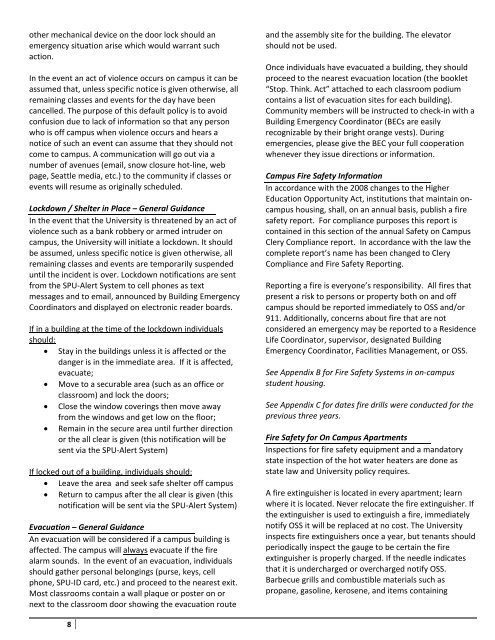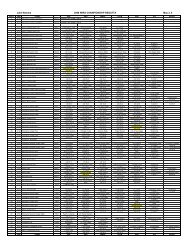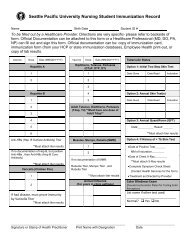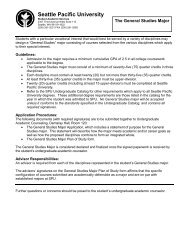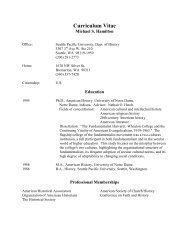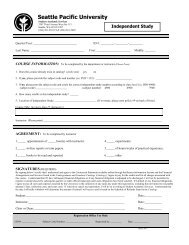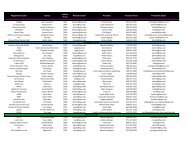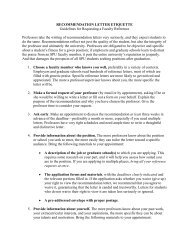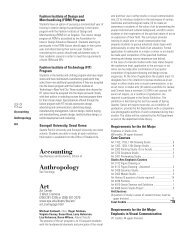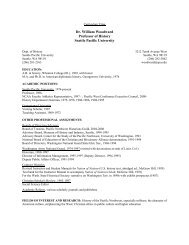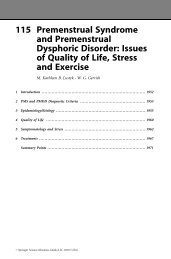2011 Annual Security & Fire Safety Report - Seattle Pacific University
2011 Annual Security & Fire Safety Report - Seattle Pacific University
2011 Annual Security & Fire Safety Report - Seattle Pacific University
Create successful ePaper yourself
Turn your PDF publications into a flip-book with our unique Google optimized e-Paper software.
other mechanical device on the door lock should an<br />
emergency situation arise which would warrant such<br />
action.<br />
In the event an act of violence occurs on campus it can be<br />
assumed that, unless specific notice is given otherwise, all<br />
remaining classes and events for the day have been<br />
cancelled. The purpose of this default policy is to avoid<br />
confusion due to lack of information so that any person<br />
who is off campus when violence occurs and hears a<br />
notice of such an event can assume that they should not<br />
come to campus. A communication will go out via a<br />
number of avenues (email, snow closure hot‐line, web<br />
page, <strong>Seattle</strong> media, etc.) to the community if classes or<br />
events will resume as originally scheduled.<br />
Lockdown / Shelter in Place – General Guidance<br />
In the event that the <strong>University</strong> is threatened by an act of<br />
violence such as a bank robbery or armed intruder on<br />
campus, the <strong>University</strong> will initiate a lockdown. It should<br />
be assumed, unless specific notice is given otherwise, all<br />
remaining classes and events are temporarily suspended<br />
until the incident is over. Lockdown notifications are sent<br />
from the SPU‐Alert System to cell phones as text<br />
messages and to email, announced by Building Emergency<br />
Coordinators and displayed on electronic reader boards.<br />
If in a building at the time of the lockdown individuals<br />
should:<br />
Stay in the buildings unless it is affected or the<br />
danger is in the immediate area. If it is affected,<br />
evacuate;<br />
Move to a securable area (such as an office or<br />
classroom) and lock the doors;<br />
Close the window coverings then move away<br />
from the windows and get low on the floor;<br />
Remain in the secure area until further direction<br />
or the all clear is given (this notification will be<br />
sent via the SPU‐Alert System)<br />
If locked out of a building, individuals should:<br />
Leave the area and seek safe shelter off campus<br />
Return to campus after the all clear is given (this<br />
notification will be sent via the SPU‐Alert System)<br />
Evacuation – General Guidance<br />
An evacuation will be considered if a campus building is<br />
affected. The campus will always evacuate if the fire<br />
alarm sounds. In the event of an evacuation, individuals<br />
should gather personal belongings (purse, keys, cell<br />
phone, SPU‐ID card, etc.) and proceed to the nearest exit.<br />
Most classrooms contain a wall plaque or poster on or<br />
next to the classroom door showing the evacuation route<br />
and the assembly site for the building. The elevator<br />
should not be used.<br />
Once individuals have evacuated a building, they should<br />
proceed to the nearest evacuation location (the booklet<br />
“Stop. Think. Act” attached to each classroom podium<br />
contains a list of evacuation sites for each building).<br />
Community members will be instructed to check‐in with a<br />
Building Emergency Coordinator (BECs are easily<br />
recognizable by their bright orange vests). During<br />
emergencies, please give the BEC your full cooperation<br />
whenever they issue directions or information.<br />
Campus <strong>Fire</strong> <strong>Safety</strong> Information<br />
In accordance with the 2008 changes to the Higher<br />
Education Opportunity Act, institutions that maintain oncampus<br />
housing, shall, on an annual basis, publish a fire<br />
safety report. For compliance purposes this report is<br />
contained in this section of the annual <strong>Safety</strong> on Campus<br />
Clery Compliance report. In accordance with the law the<br />
complete report’s name has been changed to Clery<br />
Compliance and <strong>Fire</strong> <strong>Safety</strong> <strong>Report</strong>ing.<br />
<strong>Report</strong>ing a fire is everyone’s responsibility. All fires that<br />
present a risk to persons or property both on and off<br />
campus should be reported immediately to OSS and/or<br />
911. Additionally, concerns about fire that are not<br />
considered an emergency may be reported to a Residence<br />
Life Coordinator, supervisor, designated Building<br />
Emergency Coordinator, Facilities Management, or OSS.<br />
See Appendix B for <strong>Fire</strong> <strong>Safety</strong> Systems in on‐campus<br />
student housing.<br />
See Appendix C for dates fire drills were conducted for the<br />
previous three years.<br />
<strong>Fire</strong> <strong>Safety</strong> for On Campus Apartments<br />
Inspections for fire safety equipment and a mandatory<br />
state inspection of the hot water heaters are done as<br />
state law and <strong>University</strong> policy requires.<br />
A fire extinguisher is located in every apartment; learn<br />
where it is located. Never relocate the fire extinguisher. If<br />
the extinguisher is used to extinguish a fire, immediately<br />
notify OSS it will be replaced at no cost. The <strong>University</strong><br />
inspects fire extinguishers once a year, but tenants should<br />
periodically inspect the gauge to be certain the fire<br />
extinguisher is properly charged. If the needle indicates<br />
that it is undercharged or overcharged notify OSS.<br />
Barbecue grills and combustible materials such as<br />
propane, gasoline, kerosene, and items containing<br />
8


